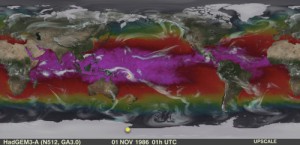Environment
Climate change, pollution and other environment issues are becoming urgent issues given the societal and economic impact it has.
Environment is studied through a wide range of disciplines commonly referred as Earth Sciences. They encompass the study of the atmosphere, the oceans, the biosphere to issues related to the solid part of the planet.
Earth Sciences address many important societal issues from weather prediction to air quality, ocean prediction, climate change to natural hazards such as seismic and volcanic hazards. As example, climate characteristics determine what agricultural crops can grow at some place, where people can live, or how cities and industries can develop. Forecasting climate change is crucial to determine its impact and help planning industrial or societal activities.
Among all issues WCES concentrates on two main domains, on the one hand weather and climate, which share some similarities, and on the other hand solid earth.
Climate evolution is driven by both anthropogenic forcing (greenhouse warming) and by natural fluctuations.
Most of the work done up to now has been devoted to improving the description of greenhouse warming and to evaluate its impacts. On the other hand natural climate variability is driven, among others, by oceanic fluctuations which take place in the Atlantic and/or in the Pacific, with characteristic time-scales of a few years to a few decades.
Besides improving the description of greenhouse-induced climate change and its course over the next decades and centuries, what we call climate predictions, it will be more and more important to forecast what detailed climate will occur in 5 years, or 10 years, of 30 years in the future, because such climate characteristics are crucial for planning most of the industrial and societal activities.
Weather prediction, air quality, ocean prediction, climate change to natural hazards such as seismic and volcanic hazards, are becoming prevalent activities where high performance computing is a necessity.
The above representation is the result of a spatial resolution of 25 km cloud and convection processes simulation
As a step forward to reaching the longer-term, 1-km resolution, this simulation has been performed during the UPSCALE project
using the Met Office Global Atmosphere Unified Model on the PrACE Tier0 machine Hermit

